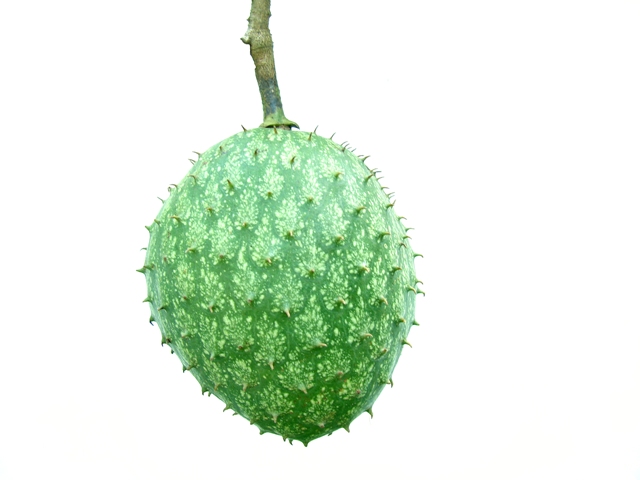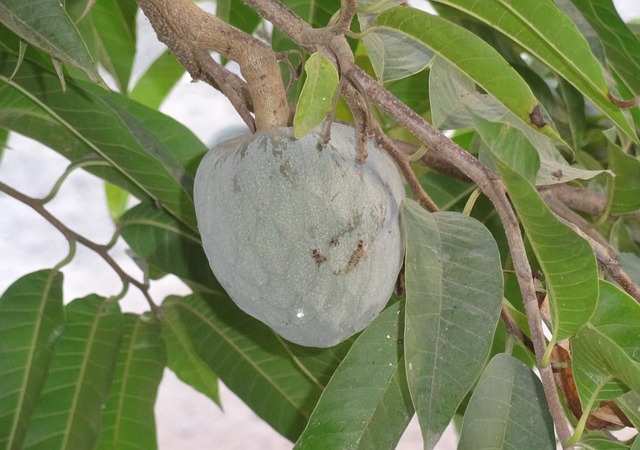Soursop: Origins - Consumption - Nutrition Facts - Health Benefits
|
|
|
Contents
- Geographic origin and regions grown
- Common consumption today
- Nutrition Facts: Vitamins, minerals and phytochemical components
- Health Benefits: Medicinal uses based on scientific studies
- Bibliography
Geographic Origins and Regions Grown

The soursop or soursap originating in the Central and South America region and north into the Caribbean is a broadleaf flowering evergreen tree. It can be found growing in Southeast Asia as well where it goes by the name Sirsak. The soursop belongs to the same genus as the cherimoya and the same family as the pawpaw. It grows as big as 12" long and 6" wide, weighing several pounds.
Common Consumption Today
I’m sure it is just a coincidence that the shape and look of a strawberry also represents one of its possible flavors. It can also taste like a pineapple with hints of a sour citrus mixing with a touch of coconut or banana. It is exotic and delicious, though an acquired taste to many.
Its edible white pulp is entrenched in membranes and populated with indigestible black seeds – try 30 to 200 seeds in each fruit. It is rare to find a seedless variety. But at least the seeds are big enough that you can bite and eat a soursop and then just spit the seeds out like you would with a watermelon.
If you had to prepare it, you would find that the knobby spines break off easily on the ripe fruit. The thin green skin is leathery and inedible but is easily cut to invite you to try the soursop’s juicy and fragrant, fibrous cream colored flesh. If you have a less acidic variety you’ll want to cut in sections and grab a spoon. Add some sugar and cream or toss together with other fruits.
Soursop has the unique distinction of being the only species in the genus Annona that can be processed and preserved. That sounds better than attempts at eating it raw. How about some candy or ice-cream with the pits already removed?
“Guanabana” is Spanish for soursop ice cream that is found in specialty markets where you can find preserved soursop syrup as well. Soursop is also great for shakes, juices and other beverages, along with tarts and sherbets. If you can’t find it fresh, you can find canned pulp to puree or blend for a dessert.
Around the tropics soursop is mostly famous for its drinks. There is champola in Brazil and carato in Puerto Rico. If you plan on trying your hand at mixing juices and drinks make sure that all the seeds are removed due to their somewhat toxic nature. Once seeded, you’re good to go squeezing your juice through cheesecloth and then beating with whatever ingredients you plan to use based on your recipe.
In other countries it is served in a variety of ways as ice cream and other desserts. But in its unripe state the soursop also makes an appearance as a vegetable or in soup in Indonesia. In parts of Brazil soursop is enjoyed fried or roasted.
Nutrition Facts: Vitamins, Minerals and Phytochemical Components

Nutritionally, the fruit is high in carbohydrates, particularly fructose, and considerable amounts of vitamins C, B1, B2, potassium and dietary fiber. It is also low in cholesterol, saturated fat and sodium. Follow the link below for the full details on the fruit's nectar...
Soursop Nutrition Facts (nectar)
Health Benefits: Medicinal Uses Based on Scientific Studies
Considered to be analgesic (relieves pain), antispasmodic (prevents spasms), sudorific (increases sweat) and emetic (medicine to cause vomiting). All parts of the soursop plant are used in herbal medicine around the world: the roots, leaves, fruit and seeds.
The juice of the ripe fruit is said to be diuretic and used in various treatments including for hematuria and urethritis. It is used for liver health while fasting. The flesh of an acid soursop is can be used as a poultice. A tea of soursop leaves can induce sleep. Some cultures put the leaves on the bed to help induce sleep as well (1).
Wet compresses of the leaves are used on inflamed or swollen feet. A poultice of mashed leaves is used to alleviate skin afflictions like eczema or treat rheumatism. The sap of young leaves alone can be put directly on skin eruptions. Crushed fresh leaves as well are used on skin eruptions to expedite healing and may actually help eliminate scarring.
The use of the soursop’s roots has many uses as well, such as remedying worms and intestinal parasites and the root bark it is an antidote for poisoning. Soursop flowers are believed to alleviate catarrh. A decoction of leaves is used to kill bedbugs and head lice. The sap of the leaves is also believed to have healing properties, and can be used as a poultice to relieve swelling and eczema.
There are phytochemicals in the leaves, seeds and stem of the soursop, which are cytotoxic against various types of cancer cells. Therefore, cancer research on the soursop is ongoing. It seems that in contrast with chemotherapy that indiscriminately seeks and destroys all actively reproducing cells, soursop phytochemicals selectively target cancer cells, leaving all healthy and normal cells undisturbed (2).
Bibliography
1. Magassouba, F. B., Diallo, A., Kouyate, M., Mara, F., Mara, O., Bangoura, O., et al. (2007). Ethnobotanical survey and antibacterial activity of some plants used in Guinean traditional medicine. Journal of Ethnopharmacology, 114(1), 44-53.
2. Soubir, T. (2007). Antioxidant activities of some local bangladeshi fruits (Artocarpus heterophyllus, Annona squamosa, Terminalia bellirica, Syzygium samarangense, Averrhoa carambola and Olea europa). Sheng Wu Gong Cheng Xue Bao, 23(2), 257-261.
Disclaimer
Nutritiousfruit.com provides this website as a service. Although the information contained within the website is periodically updated, no guarantee is given that the information provided is correct, complete, and/or up-to-date. The materials contained on this website are provided for general information purposes only and do not constitute legal or other professional advice on any subject matter. Nutrtiousfruit.com does not accept any responsibility for any loss, which may arise from reliance on information contained on this website. The information and references in this website are intended solely for the general information for the reader. The content of this website are not intended to offer personal medical advice, diagnose health problems or to be used for treatment purposes. It is not a substitute for medical care provided by a licensed and qualified health professional. Please consult your health care provider for any advice on medications.
Didn't find what you were looking for? Search here...

Amazon Search Box:
Did you like this page?
|
|
|




